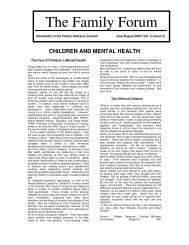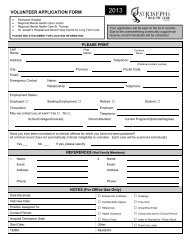Winter 2010 - St. Joseph's Health Care London
Winter 2010 - St. Joseph's Health Care London
Winter 2010 - St. Joseph's Health Care London
Create successful ePaper yourself
Turn your PDF publications into a flip-book with our unique Google optimized e-Paper software.
14<br />
SORENESS, NOT<br />
PAIN, is part of<br />
WORKING OUT.<br />
The AFTEREFFECTS<br />
f you do all the right steps and DOMS still rears its ugly<br />
head, don’t worry. The soreness should be gone in a day<br />
or two. And the good news is that with each workout,<br />
you’ll feel it a little less. That’s because your muscles adapt to<br />
the stress you put them under. If you decide to up your intensity,<br />
weight, duration or speed, however, expect DOMS again<br />
as your muscles react to the new stimulus.<br />
It may seem counterintuitive, but when soreness sets in,<br />
one of the best things you can do is go out the next day and<br />
have a light workout. “Light” being the key word.<br />
Getting off the couch actually will reduce the soreness,<br />
Becker explains. “The idea is to use the same muscles in a different<br />
way so that you can fl ush out the lactic acid that builds<br />
up,” he says. Massage, hydrotherapy and alternating applications<br />
of heat and cold also can help.<br />
When your pain goes beyond soreness, that’s the time to<br />
take a step back and assess. Is the pain sharp or in a specifi c<br />
area? Is there pain in a joint or a muscle? Did you hear a pop<br />
during a workout? “DOMS is going to be broad, not point specifi<br />
c,” Becker explains. “It will literally be hard to ‘put a fi nger<br />
on it.’ ”<br />
For sharp pains, follow the RICE prescription: rest, ice,<br />
compression and elevation. If you have swelling, try taking<br />
a non-steroidal anti-infl ammatory, such as Advil. If you follow<br />
the RICE plan and the pain doesn’t go away in one to<br />
three weeks, it’s time to see a doctor. Severe pain should be<br />
treated immediately.<br />
Remember, soreness, not pain, is part of working out. “You<br />
don’t need to destroy your body to get results,” Greenfi eld<br />
says. “You can get enormous benefi ts from a walk.”<br />
Vim & Vigour · WINTER <strong>2010</strong><br />
online<br />
When It’s<br />
More Serious<br />
If you have a nagging pain or injury, don’t just grin and<br />
bear it or ignore it and hope it will go away. You could<br />
end up doing more damage.<br />
“After you run or work out on the elliptical trainer,<br />
you’re going to feel it in parts,” says Michael Hermiston,<br />
physiotherapist at <strong>St</strong>. Joseph’s Hospital. “But on a scale<br />
of one to 10, a four or five is OK. But if it doesn’t go away<br />
in one to three weeks, something is more irritated than<br />
you probably realize.” That’s when it’s time to seek help.<br />
Specifically, don’t ignore these signs:<br />
• Joint pain<br />
• Point-specific tenderness<br />
• Swelling<br />
• Numbness or tingling sensations<br />
• Decreased range of motion<br />
• Weakness on one side<br />
Hermiston says that seeing your doctor early can<br />
help avoid further injuries. “When your body compensates<br />
for an injured or vulnerable spot, then you’re at<br />
risk for other injuries,” he explains.<br />
FREE Exercise<br />
Guide<br />
If you’re ready to get into shape, visit<br />
www.paguide.com to download<br />
“Canada’s Physical Activity Guide to<br />
<strong>Health</strong>y Active Living” or search for a<br />
certified exercise physiologist in<br />
your area at www.csep.ca.










